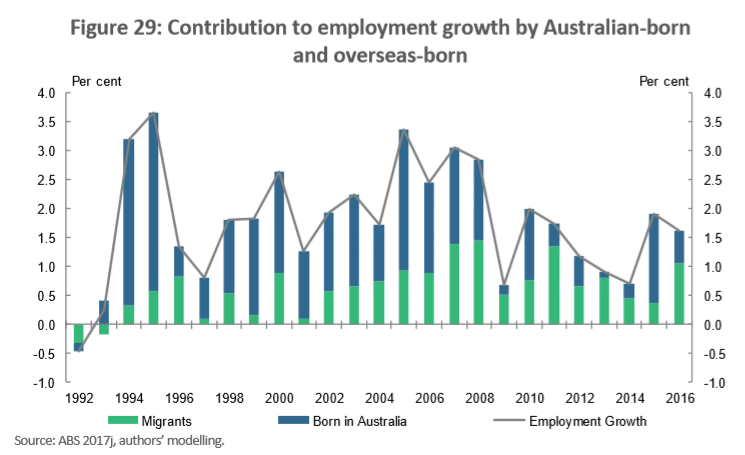Over many years, MB has consistently argued that mass immigration is helping to hold down Australian wages.
The economics is straightforward: when the working aged population continually increases via immigration, competition for jobs intensifies, worker bargaining power gets eroded, unemployment and underemployment remains elevated, and wages are held down.
The situation in Australia is particularly problematic because employers, through multiple visa programs, have been granted the ability to readily hire cheap migrant workers under the ruse of ‘skills shortages’, thus eliminating the need to train locals, as well as undercutting both wages and working conditions.
Yesterday’s Statement of Monetary Policy from the Reserve Bank of Australia (RBA) tacitly admitted that strong labour supply from mass immigration is keeping unemployment/underemployment elevated and contributing to a lack of wage pressures:
Employment has grown strongly over recent years and labour force participation is at a record high. There has, however, been little inroad into the spare capacity in the labour market recently, with the unemployment rate having risen slightly to 5.2 per cent…
Wages growth remains subdued and there is little upward pressure at present, with strong labour demand being met by more supply…
Taken together, recent labour market outcomes suggest that the Australian economy can sustain lower rates of unemployment and underemployment.
Last year’s speech on inflation by RBA Assistant Governor, Guy Debelle, similar admitted that immigration is holding down wages [my emphasis]:
There is considerable uncertainty about the extent of unutilised capacity in the labour market and how quickly a reduction in spare capacity would translate into higher wage and price inflation. It is possible that the unemployment rate could fall faster than expected and wages growth could pick up more strongly as a result. Alternatively, it is possible that the flow of new workers into the labour force could continue to be stronger than usual, so that unemployment declines more slowly than we expect and wage pressures could take longer to emerge.
Clearly, the mass importation of migrant workers is the driver of “the flow of new workers into the labour force”, which has caused unemployment to “decline more slowly” and “wage pressures… [to] take longer to emerge”. There is no other explanation.
Interestingly, Melbourne University demographer, Professor Peter McDonald, also last week admitted that three quarter of new jobs have been taken by migrants, thus displacing local workers:
“In recent times, about 75 per cent of employment growth in Australia can be attributed to recent immigrants”.
A 2017 research paper by Professor McDonald published in the Australian Population Studies Journal examined the impact of immigration on Australia’s employment growth after the Global Financial Crisis (July 2011 to July 2016).
It found that in the five-year period, employment in Australia increased by 738,800, with immigrants accounting for 613,400 of these jobs.
This follows the Australian Treasury’s recent report, entitled Shaping a Nation, which similarly found that migrants accounted for two-thirds of jobs created in the five years to 2016 and nearly three-quarters of full-time jobs created:

Modelling by both the Productivity Commission and Victoria University also shows unambiguously that immigration flattens wages.
Therefore, instead of providing jobs, Australia’s open migrant visa system is undercutting workers, crush-loading our cities, and forcing people to live in smaller and more expensive housing.
The bigger questions is: why isn’t the union movement and “Labor” party up in arms and fighting back? When will they stand up for ordinary Australians?

